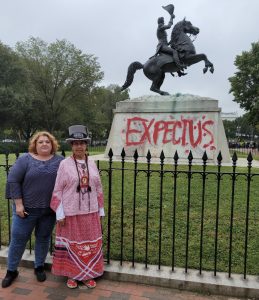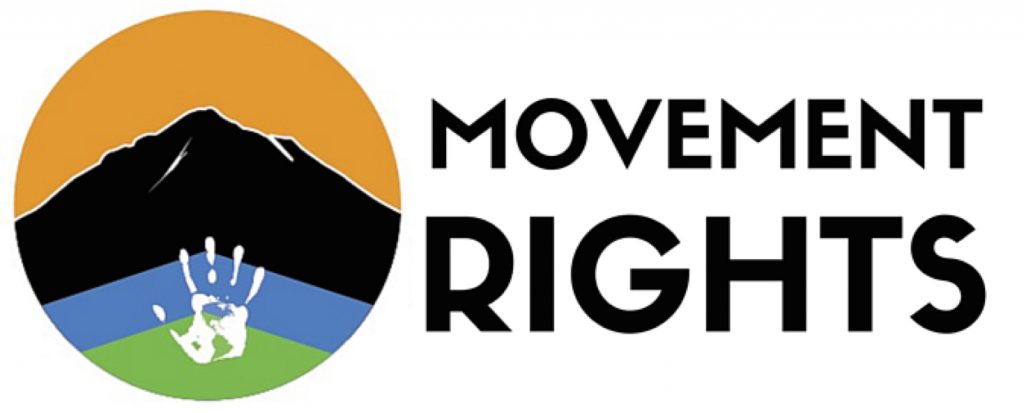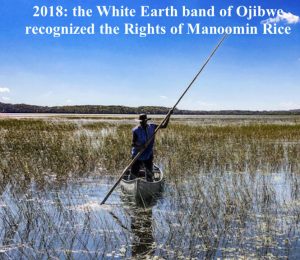By Casey Camp Horinek & Shannon Biggs
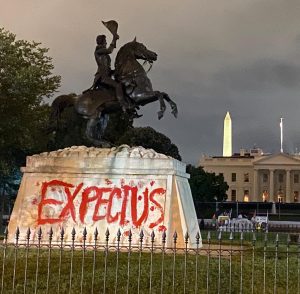
By the hundreds we came to the so-called seats of power—the White House, the US Capitol, the Department of the Interior and the Bureau of Indian Affairs. Amidst a pandemic that still rages, we left our families, tribal homelands, caring communities on the frontlines of fossil fuel destruction. We came to risk arrest and lay bare the seriousness of the climate crisis at the Administration’s front door. We called on Biden to declare a climate emergency and to use the power of the pen to sign executive orders to cancel fracking permits, petrochemical facilities, pipelines including Line 3, carbon trading and put an end to the fossil fuel era.
The historic People Vs Fossil Fuels organized by #Build Back Fossil Free, a coalition of frontline and climate justice organizations including Movement Rights, took place October 11-15, 2021. Beginning on Indigenous Peoples Day, hundreds of people marched from Freedom Plaza—once a bustling center for the Washington DC slave trade—to the White House and the US Capitol. During the week the first Indigenous occupation of the Secretary of the Interior’s Bureau of Indian Affairs since the 1970s took place.
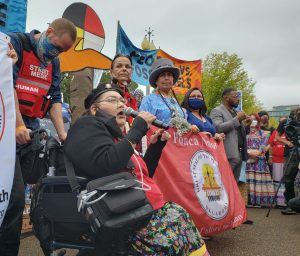
Each day thousands of people in DC and online watched powerful testimony from fossil fuel frontline communities from the Gulf to the Arctic Circle. For the first time during the Biden administration, mass arrests were made at the White House. Indigenous people occupied the Bureau of Indian Affairs for the first time in 30 years. In total, 655 people were arrested, 3 million tweets were logged, and hundreds of national and global media stories were filed. On the last day, youth led a march to the march to the Capitol to let elected officials know they did not—and would not—vote for those paying lip service to addressing climate change while sitting snugly in the pockets of the fossil fuel industry.
But after the last of the water protectors made the weary trek home, and the media cameras moved on, the question is: did we leave an indelible mark on the administration before they participate in the UN COP 26 climate negotiations in Glasgow? Surely by now, even the last tell-tale sign of our presence—the graffiti “EXPECTUS” anonymously painted on Andrew Jackson’s statue in Lafayette park—has been scrubbed away.
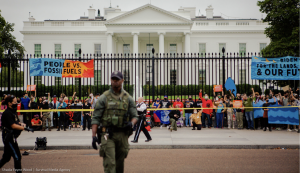
According to many sources, it appears that pressure is building on the White House following the week-long “People vs. Fossil Fuels” mobilization. On Friday, October 22, 13 members of Congress sent a letter to the President urging action on the coalition’s demands to declare a climate emergency and stop approving fossil fuel projects. Climate Envoy for the US, John Kerry, said that the COP26 summit is the “last best hope for the world to get its act together”.
The world’s scientists unanimously agree that the answer to stopping the worst impacts of climate chaos is to Stop. Burning. Fossil. Fuels. No carbon offsetting, no mere reduction in fossil fuel use, but a complete halt. The Climate Crisis is already killing us. A just economic transition to renewable energy is viable. So just what and who are we waiting for?
“We are tired of waiting for climate action, @POTUS,” Rep. Cori Bush tweeted. “Your inaction is undermining our efforts to deliver good jobs, environmental justice, and a renewable energy future. You have the power to stop fossil fuel expansion and halt dangerous pipelines now. Now is the time to use it.”
Powerful Testimony During People Vs Fossil Fuels
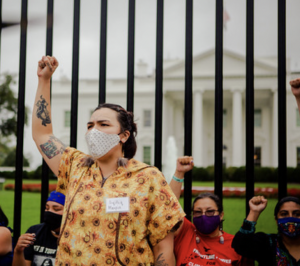
Each day of the People Vs Fossil Fuels mobilization at the White House, roughly 100 people were arrested in groups of one to four at a time. Across Pennsylvania Avenue, hundreds more gathered at the edge of Lafayette Park to witness the arrests, and to hear testimony from Indigenous and communities of color who live on the frontlines of climate disaster and fossil fuels. These are the same communities that carried Biden to victory during the last election. But despite Indigenous and Black voters being largely responsible for swinging the election, they have no illusions about Biden as a climate savior.
Siqiñiq Maupin is the executive director of Sovereign Iñupiat for a Living Arctic. During her moving testimony, she shared that thousands of Alaskan residents have been forced to flee their homes. Whole villages are becoming climate refugees forced to seek drier ground. “People are dying right now from the pollutants, the toxins, the climate catastrophes that are happening, and we have to stop the harm,” Maupin said. “Biden’s election was riding on climate change, his entire election on people of color, Indigenous people. But when it really comes to when it matters, our lives are still being sacrificed for oil and gas.”
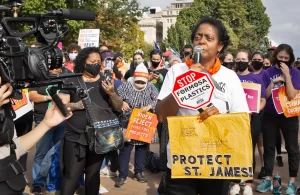
“I want to tell our President Joe Biden, you campaigned on Cancer Alley. That’s where I live. People are dying rapidly. People are dying of cancer and other ailments,” said Sharon Lavigne, 2021 recipient of the prestigious Goldman Environmental Prize for her work with Rise St James, a grassroots organization that is fighting plastics and petrochemical facilities killing her community. “President Biden, I sent you a video to tell you about our community. I’ve asked you to come to see where we live, to come and visit us and get a whiff of all the chemicals that we’re breathing. You promised that you would do something for Death Alley. We haven’t seen anything yet. We want to hold you to what you said to us in your campaign. We voted for you, and this is the way you treat us? You are letting us down by not even coming to see about us.”
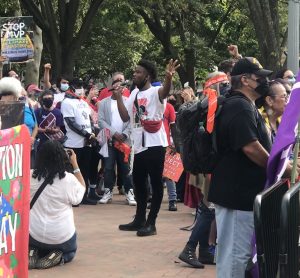
“When these hurricanes came and they hit the East coast and the Gulf, and it rained on the East Coast for hours, people were left behind. My 71-year old grandmother was left with 19 feet of water around her,” said Kevin Cramer, a resident of Wilmington, DE who works with Palm Collective, a Black-led organization that works to end systemic racism in DC. “If you’re poor and Black and can’t afford flood insurance, how are you supposed to repair? I almost lost my grandmother and my community because Joe Biden doesn’t care about us.”
What’s at Stake at COP 26: False Solutions will Make Everything Worse
Placing the blame squarely on fossil fuels, the report from the Intergovernmental Panel on Climate Change (IPCC) warned that current greenhouse gas levels guarantee climate disruption for decades if not centuries. While high profile attention such as the People Vs Fossil Fuels mobilization and the IPCC report have made it politically unfeasible for the fossil fuel industry to have an “official role” at COP 26 climate negotiations in Glasgow, the stage has been set.
“Net zero emissions” and “Nature-Based Solutions” are already baked into the COP 26 negotiations. They sound good, but don’t be fooled. These are nothing more than Ponzi schemes that change nothing. As climate scientists warn, these are nothing but a dangerous trap. “The idea of net zero has licensed a recklessly cavalier ‘burn now, pay later’ approach which has seen carbon emissions continue to soar. It has also hastened the destruction of the natural world by increasing deforestation today, and greatly increases the risk of further devastation in the future.”
In the days leading up to the COP 26, a document leak reveals oil and coal producing countries have been secretly lobbying to “soften” the IPCC report. Even more alarming, The UNEP production gap report says that fossil fuel production is set to soar over next decade.

The U.K.’s COVID travel protocols prevent thousands of global civil society representatives from showing up in Glasgow. Those of us that will be there on the ground and through virtual events, will continue sounding the alarm, including a contingent from Build Back Fossil Free. Many of us feel going to COP 26 is critical because it’s going to take all of raising our voices. Real solutions exist and can be implemented from the highest levels to local communities. We will be there to tell heads of state, ‘We were there at COP 21 in Paris. It wasn’t enough then and it’s not enough now’ The Paris Agreement’s voluntary targets were not only inadequate in 2015, but didn’t take into account the increasing devastation of wildfires, catastrophic floods, melting of the ice caps, rising sea levels drought, pandemics and more that have occurred in the last 6 years. It’s all related. We are all related.
Upon the Biden administration’s return from Glasgow, we won’t stop. We won’t stop putting our bodies on the line at Line 3, DAPL, Liquified Natural Gas terminals, in Cancer Alley, the Arctic, at all frontline fights, on the streets, across the nation and back at the White House.
In many ways, showing up at Biden’s front door wasn’t about expecting radical change from the “halls of power.” It was and is about showcasing where power really resides, and where solutions really exist. Politicians never follow where grassroots movements for justice don’t lead.
We have the power to change everything, with or without the political will in Glasgow—it’s just another venue to sound the alarm that after 25 years of failed COPs, Glasgow isn’t likely to do anything close to what is needed. That is part of the lesson and message of the People Vs Fossil Fuels week of action. Respect us, or #Expectus. We’re not going away.
Respect us or #Expectus: Indigenous People are Rising up for Mother Earth and You, too
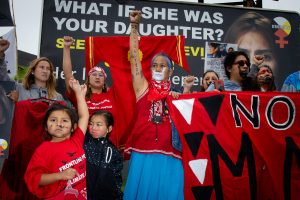
For many Indigenous people, 250 years of Presidents come and go with little difference from one to the other, including the current President and the last one. That can be hard for some non-Indigenous Americans to grasp. But from Andrew Jackson’s Indian Removal Act, to the breaking of virtually every treaty, the testing of the nuclear bomb on Native lands in New Mexico, to the continued assault of the fossil fuel industry, the violence against their lands and peoples has not diminished. Today, murder rates for Indigenous Women are 10x higher than all other ethnicities. The rise of fossil fuel “man camps” play a central role in the rise of sexual violence and Missing and Murdered Indigenous Women (MMIW).
Understandably, many Indigenous people, frontline communities and climate justice activists hold little faith that the Biden administration will truly address climate change as the defining crisis of human history, because to do so requires more than bidding for the next election. It requires system change, a radical economic and culture shift, and a lot more allies to stand with us. So why did we come to DC?
As Joye Braun of the Cheyenne River Sioux Tribe and the Indigenous Environmental Network, told Democracy Now, “The United States government brought the frontlines to us, to the Indigenous people, to our doorsteps,” says Braun. “And we wanted to bring the frontlines to his doorstep to let him see that we are very serious about climate change and declaring a climate emergency.”
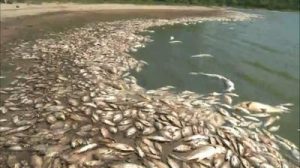
Adult members of the Ponca Nation still remember growing their own food, hunting and fishing to provide for their families. But they can’t do that anymore. The soil is too polluted to grow anything organic. Fish are dying, and animals have cancers and growths that make them unsafe to eat. Everything has changed in just the last human generation. But we can accomplish a way forward for all of our grandchildren and great-grandchildren to be able to breathe, to eat and to drink, and to leave a legacy that survives this crucial moment in time.
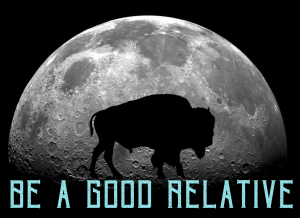
Indigenous activists bring generational knowledge of the battles against pipelines and drilling around reservations and a deep understanding of the land that can pave a path forward in tackling climate change. During this week of action, part of our message to the President and the people of the US has been to declare a national climate emergency. We’re capable of that. But in reality, all countries must move swiftly to live within the boundaries of natural law. Indigenous people worldwide have ancestral knowledge of how to live in balance with the only planet we call home. The solutions already exist including how to build a truly thriving economy without fossil fuels. We don’t have to fear a just transition. But If we don’t act, Mother Earth will simply shake us off her back, and that time is quickly approaching if we continue with a business as usual approach.
Indigenous Solutions: Rights of Nature, Indigenous Rights & Land Back
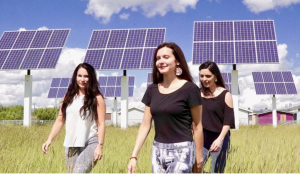
We can recreate a society that is functional. That might mean using only sustainable food sources, using natural seeds, community seeds. It might mean taking money from fossil fuel subsidies and moving them toward solar and wind energy. It also means not being fooled by the jargon of so-called “Nature-Based solutions” which are nothing more than fraudulent corporate green-washing.
Indigenous wisdom has been at the forefront of the climate justice movement for a generation. Despite colonization’s best efforts to kill, starve, steal and invisibilize Indigenous people, the genetic memory of living in balance with the Earth remains in us—in all of us. We can all indigenize our thinking and our way in the world.

We have had the United Nations Declaration on the Rights of Indigenous Peoples (UNDRIP) signed by every nation in the world, but with no real implementation. If that was in place, we wouldn’t be in climate crisis, because minus colonization, forced indoctrination, stolen lands and environmental genocide it is still true that Indigenous peoples are the best caretakers of Earth, on their territories and everywhere else. Indigenous peoples are protecting 80% of the worlds remaining biodiversity. Indigenous lands in Indigenous hands is critical for the survival of all humanity. So Indigenous sovereignty, landback movements and Indigenous-led Rights of Nature are on the rise because Indigenous solutions can bring us back to balance, even as we face decades of climate upheaval.
The LANDBACK movement is about the reclamation of stolen Indigenous lands, but as Krystal Two Bulls, Northern Cheyenne/Oglala Lakota Director of the NDN Collective’s Landback Campaign says, it’s deeper than that. “It’s the reclamation of the land and our caretaking responsibilities. … How to be in relationship with the land, and everything that was stolen from us. Language, ceremony, harvesting of medicine, culture, hunting and knowledge of our animal relations, structures of healthcare, decision-making. There’s no ownership in LandBack.” For white allies to be accomplices in the LandBack movement they have to deal with their own fear about what that means, and to reconcile with the history of the US as stolen lands built on the backs of stolen African people. The perpetuation of Indigenous people as invisible, and the perpetuation of anti-blackness is to reinforce the white supremacy this country was founded on.
While the fight for “LANDBACK” frightens some in the mainstream, it doesn’t have to. Scientists and policymakers have started advocating for land back for purposes of conservation and slowing the climate crisis. Ancestral knowledge evolved over centuries of living in relationship with the Earth also offers tools to manage climate catastrophes, such as forest management and wildfire control.
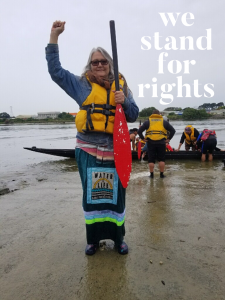
Indigenous-led Rights of Nature is another powerful movement that is reshaping how humans connect with the land. Globally, the Rights of Nature movement has been led by Indigenous peoples and cosmology that recognizes that human laws must align with the universal laws of the natural world. Indigenous wisdom understands humans are a part of nature, not owners of it. It should be apparent to any thinking person that our survival depends on our ability to place human activities within the boundaries of the Earth’s ability to absorb our impacts.
Historically, the US legal system has been hostile to recognizing Rights for the Right-less. And so long human law sees nature as property to be destroyed for profit nothing can truly shift. Only through deep on the ground organizing with national and international support can we begin to change culture and law to recognize our human responsibilities to the ecosystems that sustain life. In 2017 the Ponca Nation of Oklahoma became the first tribe in the US to recognize the Rights of Nature.
Several tribes on Turtle Island have now recognized the Rights of Nature, because in so doing it puts Indigenous concepts of relationship and responsibility to the Earth in Western legal frameworks for the first time. A powerful step that confronts the idea that nature is human property. In 2021 the Ojibwe filed the first lawsuit on behalf of the Rights of Sacred Manoomin Rice, which is threatened by the Line 3 pipeline. The lawsuit could help stop the Pipeline.
In the US, showcased at Standing Rock and everyplace from the Arctic Circle to the Bayou, to the Ponca Nation of Oklahoma, Indigenous people have always put their bodies on the line to protect the sacred system of life. “Water is Life” is not only about protecting Indigenous communities, but all living and future generations of humans, and all forms of life. If we are to avoid the worst impacts of climate chaos, humans must learn to live in balance with the laws of the natural world. Respecting Indigenous Rights, honoring treaties, and supporting Indigenous-led Rights of Nature on Turtle Island (North America) may be our best hope for the kind of powerful culture shift needed to confront a legal system that protects elite wealth and sees nature only as property to be dominated for profit.
The Power of the People VS Fossil Fuels Can’t Stop
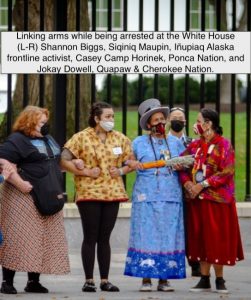 People ask, what has been the significance of the People VS Fossil Fuels and the arrests of over 600 people?
People ask, what has been the significance of the People VS Fossil Fuels and the arrests of over 600 people?
On the first day of the People Vs Fossil Fuels—Indigenous Peoples Day—over 100 Indigenous and climate allies risked arrest at the White House. Secret service and DC metropolitan police surrounded us. Sharp shooters stood atop the White House with weapons aimed at us. When the police came to begin the arrests, some resisted. Many stood up and went compliantly. Others prayed. Some raised their voices in anger. Some were unwilling to go on their own power and were lifted from the ground and dragged out by groups of policemen.
We have more power than we know. The police recognized it. Together with Jokay Dowell and Siqiñiq Maupin, the four of us sat quietly with arms locked together, our gaze fixed we sat like stones with our backs against the White House fence. We watched as the police removed people in front of us, beside us, and all around us. This unlikely group of women arm in arm became so quietly powerful, that the police played a version of “rock paper scissors” to see who would have the unwanted task of removing the “formidable four” of grandmothers, mothers, sisters, water protectors. The policeman, who had just moments before dragged out more than a few large men, was visibly uncomfortable approaching us. When we said we would go out arm in arm on our own power, he physically recoiled in relief.
We must keep reminding ourselves that as long as we stand with Mother Earth, we have more power than we know. Enough power to change everything.
